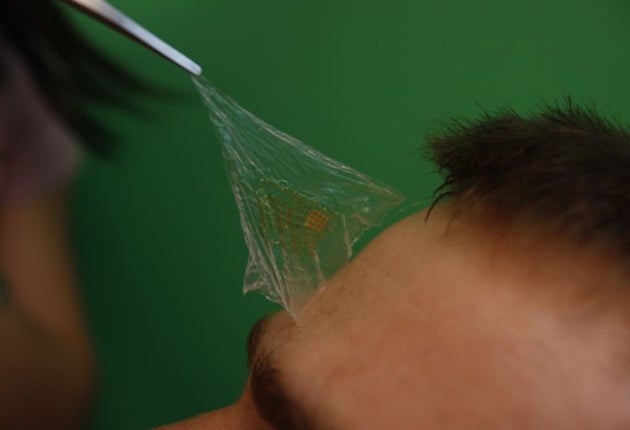How computers will soon get under our skin
A stick-on circuit can monitor heart rate as well as conventional devices, but is weightless, wireless and inconspicuous

It may soon be possible to wear your computer or mobile phone under your sleeve, with the invention of an ultra-thin and flexible electronic circuit that can be stuck to the skin like a temporary tattoo.
Click HERE to view graphic (87k jpg)
The devices, which are almost invisible, can perform just as well as more conventional electronic machines but without the need for wires or bulky power supplies, scientists said.
The development could mark a new era in consumer electronics. The technology could be used for applications ranging from medical diagnosis to covert military operations.
The "epidermal electronic system" relies on a highly flexible electrical circuit composed of snake-like conducting channels that can bend and stretch without affecting performance. The circuit is about the size of a postage stamp, is thinner than a human hair and sticks to the skin by natural electrostatic forces rather than glue.
"We think this could be an important conceptual advance in wearable electronics, to achieve something that is almost unnoticeable to the wearer. The technology can connect you to the physical world and the cyberworld in a very natural way that feels comfortable," said Professor Todd Coleman of the University of Illinois at Urbana-Champaign, who led the research team.
A simple stick-on circuit can monitor a person's heart rate and muscle movements as well as conventional medical monitors, but with the benefit of being weightless and almost completely undetectable. Scientists said it may also be possible to build a circuit for detecting throat movements around the larynx in order to transmit the information wirelessly as a way of recording a person's speech, even if they are not making any discernible sounds.
Tests have already shown that such a system can be used to control a voice-activated computer game, and one suggestion is that a stick-on voicebox circuit could be used in covert police operations where it might be too dangerous to speak into a radio transmitter.
"The blurring of electronics and biology is really the key point here," said Yonggang Huang, professor of engineering at Northwestern University in Evanston, Illinois. "All established forms of electronics are hard, rigid. Biology is soft, elastic. It's two different worlds. This is a way to truly integrate them."
Engineers have built test circuits mounted on a thin, rubbery substrate that adheres to the skin. The circuits have included sensors, light-emitting diodes, transistors, radio frequency capacitors, wireless antennas, conductive coils and solar cells.
"We threw everything in our bag of tricks on to that platform, and then added a few other new ideas on top of those, to show that we could make it work," said John Rogers, professor of engineering at the University of Illinois at Urbana-Champaign, a lead author of the study, published in the journal Science.
Join our commenting forum
Join thought-provoking conversations, follow other Independent readers and see their replies
Comments
Bookmark popover
Removed from bookmarks